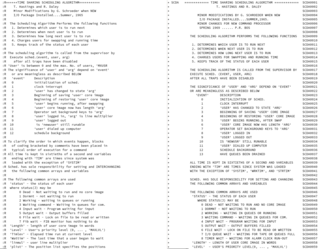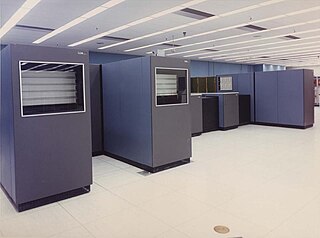Related Research Articles

Machine translation is use of either rule-based or probabilistic machine learning approaches to translation of text or speech from one language to another, including the contextual, idiomatic and pragmatic nuances of both languages.

SYSTRAN, founded by Dr. Peter Toma in 1968, is one of the oldest machine translation companies. SYSTRAN has done extensive work for the United States Department of Defense and the European Commission.

In computing, internationalization and localization (American) or internationalisation and localisation (British), often abbreviated i18n and l10n respectively, are means of adapting computer software to different languages, regional peculiarities and technical requirements of a target locale.

The IBM 650 Magnetic Drum Data-Processing Machine is an early digital computer produced by IBM in the mid-1950s. It was the first mass produced computer in the world. Almost 2,000 systems were produced, the last in 1962, and it was the first computer to make a meaningful profit. The first one was installed in late 1954 and it was the most-popular computer of the 1950s.

The Compatible Time-Sharing System (CTSS) was the first general purpose time-sharing operating system. Compatible Time Sharing referred to time sharing which was compatible with batch processing; it could offer both time sharing and batch processing concurrently.

The IBM 1360 Photo-Digital Storage System, or PDSS, was an online archival storage system for large data centers. It was the first storage device designed from the start to hold a terabit of data (128 GB). The 1360 stored data on index card sized pieces of stiff photographic film that were individually retrieved and read, and could be updated by copying data, with changes, to a new card. Only six PDSSs were constructed, including the prototype, and IBM abandoned the film-card system and moved on to other storage systems soon after. Only one similar commercial system seems to have been developed, the Foto-Mem FM 390, from the late 1960s.
The Georgetown–IBM experiment was an influential demonstration of machine translation, which was performed on January 7, 1954. Developed jointly by the Georgetown University and IBM, the experiment involved completely automatic translation of more than sixty Russian sentences into English.
ALPAC was a committee of seven scientists led by John R. Pierce, established in 1964 by the United States government in order to evaluate the progress in computational linguistics in general and machine translation in particular. Its report, issued in 1966, gained notoriety for being very skeptical of research done in machine translation so far, and emphasizing the need for basic research in computational linguistics; this eventually caused the U.S. government to reduce its funding of the topic dramatically. This marked the beginning of the first AI winter.
Martin Kay was a computer scientist, known especially for his work in computational linguistics.
Machine translation is a sub-field of computational linguistics that investigates the use of software to translate text or speech from one natural language to another.

A Chinese typewriter is a typewriter that can type Chinese script. Early European typewriters began appearing in the early 19th century. However, as the Chinese language uses a logographic writing system, fitting thousands of Chinese characters on the machine needed much more complex engineering than typewriters using a simple Latin alphabet, or other non-logographic scripts. An ordinary Chinese printing office uses 6,000 Chinese characters. Chinese typewriters, and similar Japanese typewriters invented by Kyota Sugimoto, which use kanji adopted from the Chinese writing system, started to appear only in the early 20th century. There have been at least five dozen versions of Chinese typewriters, ranging from sizable mechanical models to sophisticated electric word processors.
Weidner Communications Inc. was founded by Stephen Weidner in 1977 and marketed the Weidner Multi-Lingual Word Processing System.
Mobile translation is any electronic device or software application that provides audio translation. The concept includes any handheld electronic device that is specifically designed for audio translation. It also includes any machine translation service or software application for hand-held devices, including mobile telephones, Pocket PCs, and PDAs. Mobile translation provides hand-held device users with the advantage of instantaneous and non-mediated translation from one human language to another, usually against a service fee that is, nevertheless, significantly smaller than a human translator charges.
Digigraphics was one of the first graphical computer aided design systems to go on sale. Originally developed at Itek on the PDP-1 as EDM, the efforts were purchased by Control Data Corporation and ported to their machines, along with a new graphics terminal to support it. Systems cost almost $500,000 and supported only a few users at a time, so in spite of a number of advantages it was not cost competitive with traditional manual methods and only a few systems were sold.
DAC-1, for Design Augmented by Computer, was one of the earliest graphical computer aided design systems. Developed by General Motors, IBM was brought in as a partner in 1960 and the two developed the system and released it to production in 1963. It was publicly unveiled at the Fall Joint Computer Conference in Detroit 1964. GM used the DAC system, continually modified, into the 1970s when it was succeeded by CADANCE.
The history of natural language processing describes the advances of natural language processing. There is some overlap with the history of machine translation, the history of speech recognition, and the history of artificial intelligence.
Rule-based machine translation is machine translation systems based on linguistic information about source and target languages basically retrieved from dictionaries and grammars covering the main semantic, morphological, and syntactic regularities of each language respectively. Having input sentences, an RBMT system generates them to output sentences on the basis of morphological, syntactic, and semantic analysis of both the source and the target languages involved in a concrete translation task.
Speech translation is the process by which conversational spoken phrases are instantly translated and spoken aloud in a second language. This differs from phrase translation, which is where the system only translates a fixed and finite set of phrases that have been manually entered into the system. Speech translation technology enables speakers of different languages to communicate. It thus is of tremendous value for humankind in terms of science, cross-cultural exchange and global business.

Yandex Translate is a web service provided by Yandex, intended for the translation of web pages into another language.
References
Citations
- 1 2 Hutchins, pg. 171
- ↑ John Hutchins, "The first public demonstration of machine translation: the Georgetown-IBM system, 7th January 1954" Archived 3 March 2016 at the Wayback Machine
- 1 2 3 4 5 Hutchins, pg. 172
- 1 2 King, 1956
- ↑ Hutchins, pg. 174
- ↑ Hutchins, pg. 175
- ↑ ALPAC, pg. 20
- ↑ John Hutchins, "ALPAC: the (in)famous report" Archived 6 October 2007 at the Wayback Machine
Bibliography
- G. W. King, G. W. Brown and L. N. Ridenour, "Photographic Techniques for Information Storage", Proceedings of the IRE, Volume 41 Issue 10 (October 1953), pp. 1421–1428
- G. W. King, "Stochastic Methods of Mechanical Translation", Mechanical Translation, Volume 3 Issue 2 (1956) pp. 38–39
- J. L. Craft, E. H. Goldman, W. B. Strohm, "A Table Look-up Machine for Processing of Natural Languages", IBM Journal, July 1961, pp. 192–203
- Language Processing Advisory Committee, "Language and Machines: Computers in Translation and Linguistics", National Research Council, 1966 (widely known as the "ALPAC Report")
- John Hutchins (ed), "Gilbert W. King and the IBM-USAF Translator", Early Years in Machine Translation, Joh Benjamins, 2000, ISBN 90-272-4586-X (RADC-TDR-62-105)
- Charles Bourne and Trudi Bellardo Hahn, "A History of Online Information Services, 1963–1976", MIT Press, 2003, ISBN 0-262-02538-8